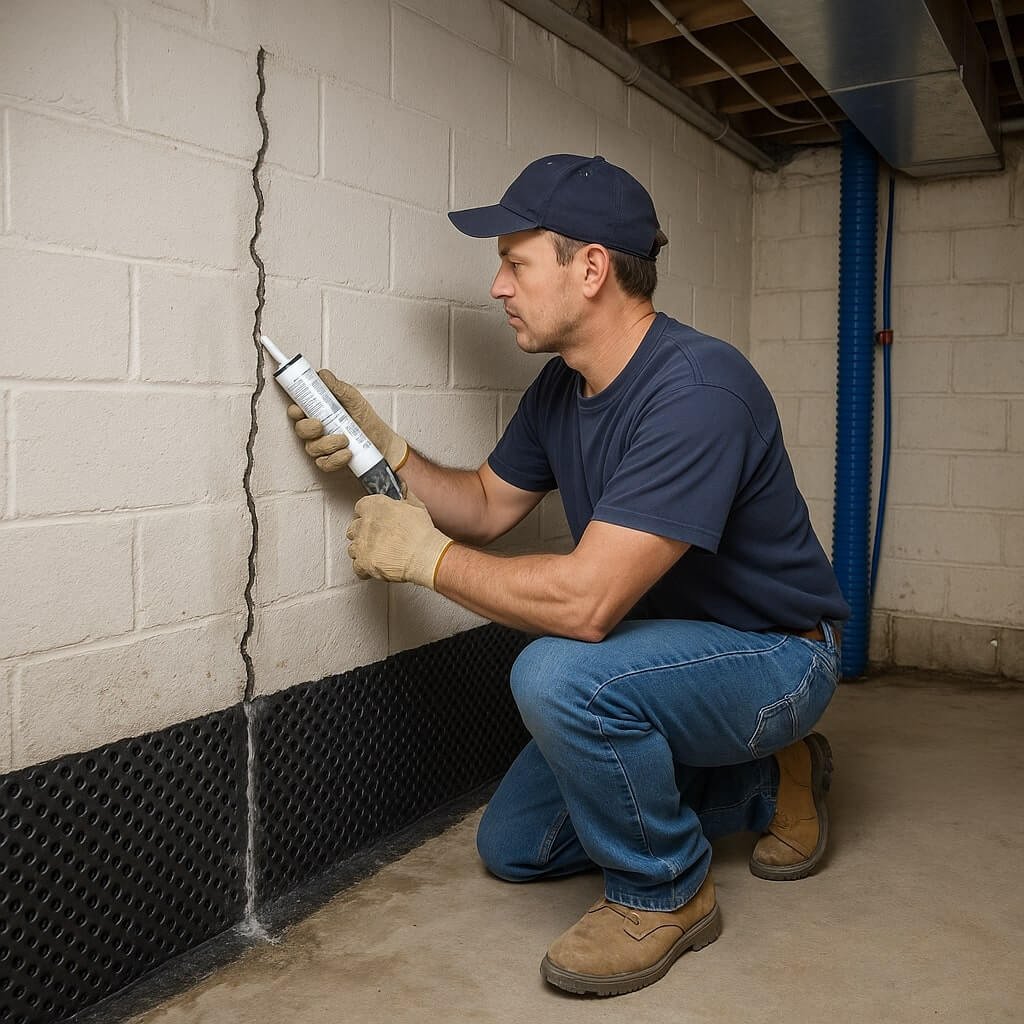If you’re dealing with basement moisture issues in Blue Springs, MO, you need a strategic approach. Start by thoroughly evaluating your basement’s current condition. Look for cracks, mold, and signs of water damage. Then, you can implement effective solutions to keep your space dry and secure. Understanding how to improve drainage and seal gaps is just the beginning of what you’ll want to know. Let’s explore the essential steps you can take.
Key Takeaways
- Conduct a thorough basement inspection for cracks, mold, and moisture using a hygrometer to identify problem areas.
- Implement proper grading techniques to direct water runoff away from the foundation at a 5% gradient.
- Seal visible cracks and gaps with high-quality fillers and durable sealants to prevent water intrusion.
- Install a sump pump to effectively drain excess water and prevent flooding in your basement.
- Utilize a dehumidifier to maintain humidity levels between 30-50% and reduce mold risks.
Assess Your Basement’s Current Condition
Before you tackle basement waterproofing, you need to assess your basement’s current condition. Start with a thorough basement inspection to identify any visible cracks, mold, or water stains.
Next, conduct a moisture evaluation by using a hygrometer to measure humidity levels and pinpoint potential problem areas. Pay attention to corners and around windows, as these spots often collect moisture.
Document your findings, which will guide your waterproofing strategy. Addressing these issues upfront will save you time and money in the long run.
Improve Exterior Drainage
To effectively prevent water from pooling around your foundation, you need to implement proper grading techniques that direct runoff away from your home.
Regular gutter maintenance is equally essential; clogged gutters can lead to overflow and increased moisture levels.
Proper Grading Techniques
Proper grading techniques are essential for directing water away from your home’s foundation, ensuring effective exterior drainage.
Start by establishing grading slopes that decline away from your foundation, ideally at a 5% gradient. This helps create effective drainage patterns.
Check for low spots that can trap water; fill them in to maintain a consistent slope. Use soil that compacts well to prevent settling over time.
Regularly inspect the grading, especially after heavy rainfalls, and adjust as needed.
Gutter Maintenance Practices
While you may not always think about it, regular gutter maintenance is essential for improving exterior drainage and preventing water from pooling near your foundation.
Start by inspecting your gutter types—whether they’re K-style or half-round—making certain they’re properly aligned and free of debris. Clean your gutters at least twice a year, or more frequently if you have overhanging trees.
Installing gutter guards can greatly reduce clogs, making maintenance easier. Don’t forget to check downspouts; verify they’re directing water at least five feet away from your home’s foundation.
Seal Cracks and Gaps
Cracks and gaps in your basement walls or floors can invite moisture and compromise the integrity of your home, so addressing these issues promptly is essential.
Start by inspecting all surfaces for visible cracks. Use a high-quality crack filler to fill any openings, ensuring you follow the manufacturer’s instructions for ideal adhesion and drying time.
For gaps, apply a durable gap sealant to prevent water intrusion. Make sure to smooth the sealant for a clean finish.
Regularly check these areas for new cracks or gaps, as proactive maintenance is key to keeping your basement dry and your home safe.
Install a Sump Pump
After sealing cracks and gaps, consider installing a sump pump to further protect your basement from water damage.
A sump pump installation effectively drains excess water, preventing flooding during heavy rains. Choose a reliable pump that fits your basement size and monitor its capacity.
Regular sump pump maintenance is essential; check the float switch, verify the discharge line is clear, and test the pump periodically.
Use a Dehumidifier
Using a dehumidifier is essential for maintaining ideal humidity levels in your basement.
By effectively reducing moisture, you can considerably prevent mold growth and protect your home’s structural integrity.
This simple yet powerful tool can make a substantial difference in your basement’s environment.
Reduce Humidity Levels
While moisture can seep into your basement through various means, one of the most effective ways to combat excess humidity is by using a dehumidifier.
This appliance actively removes moisture from the air, providing essential humidity control. Set it to maintain ideal humidity levels, ideally between 30-50%.
Guarantee proper air circulation by placing the dehumidifier centrally and keeping vents unobstructed. Regularly empty the water reservoir or opt for a continuous drainage option for efficiency.
A dehumidifier not only enhances comfort but also protects your home from potential moisture-related issues. Invest in one today for a healthier basement environment.
Prevent Mold Growth
To effectively prevent mold growth in your basement, maintaining ideal humidity levels is essential. A dehumidifier can be your best ally in mold prevention, as it reduces excess moisture that encourages mold spores to thrive.
Set your dehumidifier to maintain humidity below 60%, optimizing air circulation throughout the space. Confirm the unit is sized correctly for your basement’s square footage, and regularly empty or connect a drain hose to keep it functioning efficiently.
Combine this with proper ventilation strategies, like exhaust fans or open windows when weather permits, to further enhance air circulation and minimize mold risks in your basement.
Waterproof Your Walls
Achieving effective waterproofing for your basement walls is essential, especially when you consider the potential damage that water intrusion can cause.
To protect your home, use high-quality waterproof coatings and wall membranes. Here are some important benefits:
- Prevents costly repairs
- Reduces health risks from mold
- Increases property value
- Provides peace of mind
Start by cleaning the walls thoroughly and then apply a waterproof coating.
Consider installing wall membranes for added protection. By taking these steps, you’ll create a resilient barrier against moisture, ensuring your basement remains dry and functional.
Don’t underestimate the importance of proper waterproofing!
Maintain Gutters and Downspouts
Maintaining your gutters and downspouts is essential for preventing water from pooling around your foundation, which can lead to significant basement moisture issues. Regularly inspect and clean your gutters, ensuring proper gutter installation to facilitate efficient water flow. Consider adding downspout extensions to direct water away from your foundation.
| Maintenance Task | Frequency |
|---|---|
| Inspect gutters | Every season |
| Clean debris | Biannually |
| Check downspouts | Every season |
| Repair leaks | As needed |
| Install extensions | When necessary |
Conclusion
By following these essential tips for basement waterproofing in Blue Springs, you can greatly reduce the risk of water damage. Start with a thorough assessment of your basement, improve drainage, seal cracks, and consider a sump pump and dehumidifier. Don’t overlook waterproofing your walls and maintaining your gutters. Regular monitoring and maintenance are key to keeping your basement dry and protected. Take action now to safeguard your home from moisture issues in the future.




